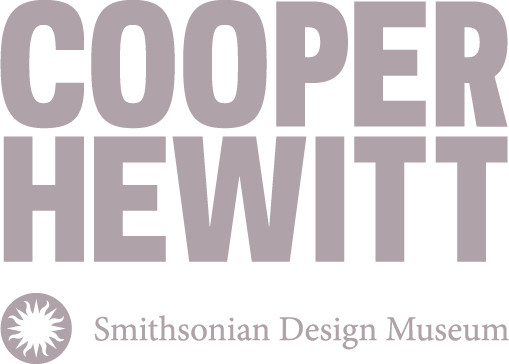SITE’s Iconic Ghost Cityscape
Michael Bullock
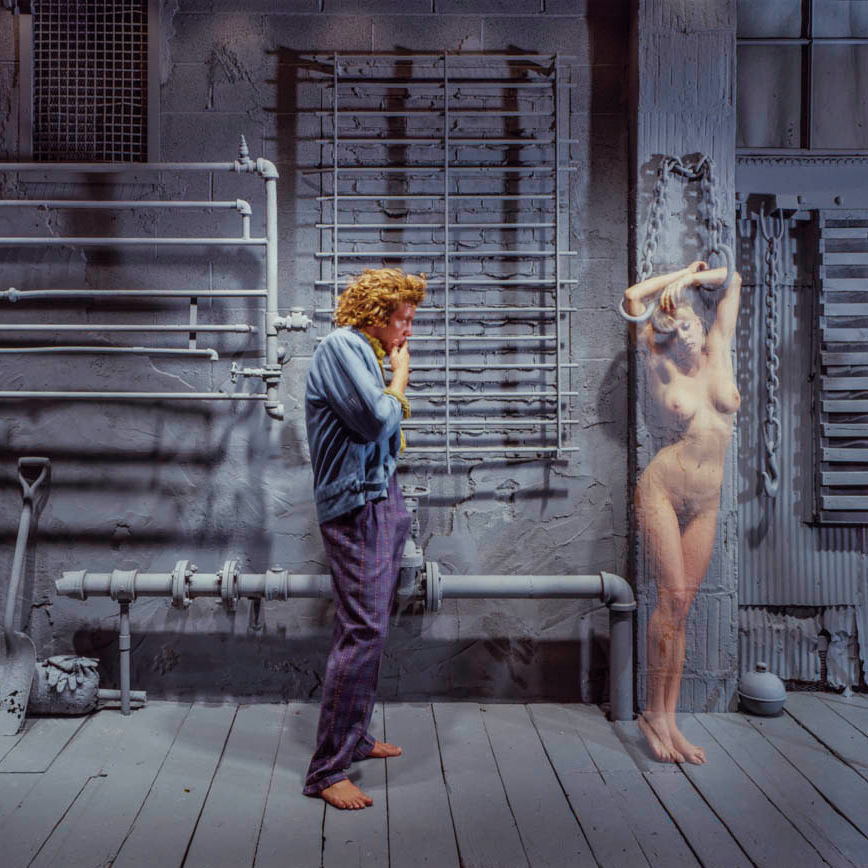 SITE for WilliWear, Showroom, New York, NY, Photographed by Andreas Sterzing, 1982
SITE for WilliWear, Showroom, New York, NY, Photographed by Andreas Sterzing, 1982
Broken windows, concrete sidewalks, bricks, a chain-link fence, industrial piping, rusting abandoned tools, and layers of eroding facades are not materials that come to mind when envisioning the showroom of a New York City−based, multimillion-dollar clothing brand. But designer Willi Smith and his business partner, Laurie Mallet, viewed upending industry convention as an opportunity for reinvention.
Finding the right architects to reimagine the traditional showroom was the result of perfect timing. As Smith and Mallet were walking down Fifth Avenue contemplating possible directions for their new home base in the Garment District, an unusual Rizzoli Bookstore display in Manhattan caught their attention. The window featured a monochrome gray, half-finished brick wall and abandoned tools. Newly released design and architecture books were scattered throughout the simulated construction site. Their covers popped against the muted, unified backdrop. The deconstruction was a bold departure from the current trends in window design and even more unusual for the prestigious uptown art bookseller whose displays typically favored elegance and refinement. The punk anti-design was conceived by SITE, a collective of artists, architects, and engineers that had banded together to challenge the conventions of the built environment with a form of conceptual thinking that had incubated in the seventies’ environmental art movement. Alison Sky, a founding partner, explains, “They had no budget and I noticed a Trump property was being built across the street. So I invited the construction workers to build a brick wall. I directed them to stop halfway and leave all their tools as if they had left for a lunch break. The Rizzoli in-house designer was so threatened by the attention our display received that he had it removed immediately.”
Finding the right architects to reimagine the traditional showroom was the result of perfect timing. As Smith and Mallet were walking down Fifth Avenue contemplating possible directions for their new home base in the Garment District, an unusual Rizzoli Bookstore display in Manhattan caught their attention. The window featured a monochrome gray, half-finished brick wall and abandoned tools. Newly released design and architecture books were scattered throughout the simulated construction site. Their covers popped against the muted, unified backdrop. The deconstruction was a bold departure from the current trends in window design and even more unusual for the prestigious uptown art bookseller whose displays typically favored elegance and refinement. The punk anti-design was conceived by SITE, a collective of artists, architects, and engineers that had banded together to challenge the conventions of the built environment with a form of conceptual thinking that had incubated in the seventies’ environmental art movement. Alison Sky, a founding partner, explains, “They had no budget and I noticed a Trump property was being built across the street. So I invited the construction workers to build a brick wall. I directed them to stop halfway and leave all their tools as if they had left for a lunch break. The Rizzoli in-house designer was so threatened by the attention our display received that he had it removed immediately.”
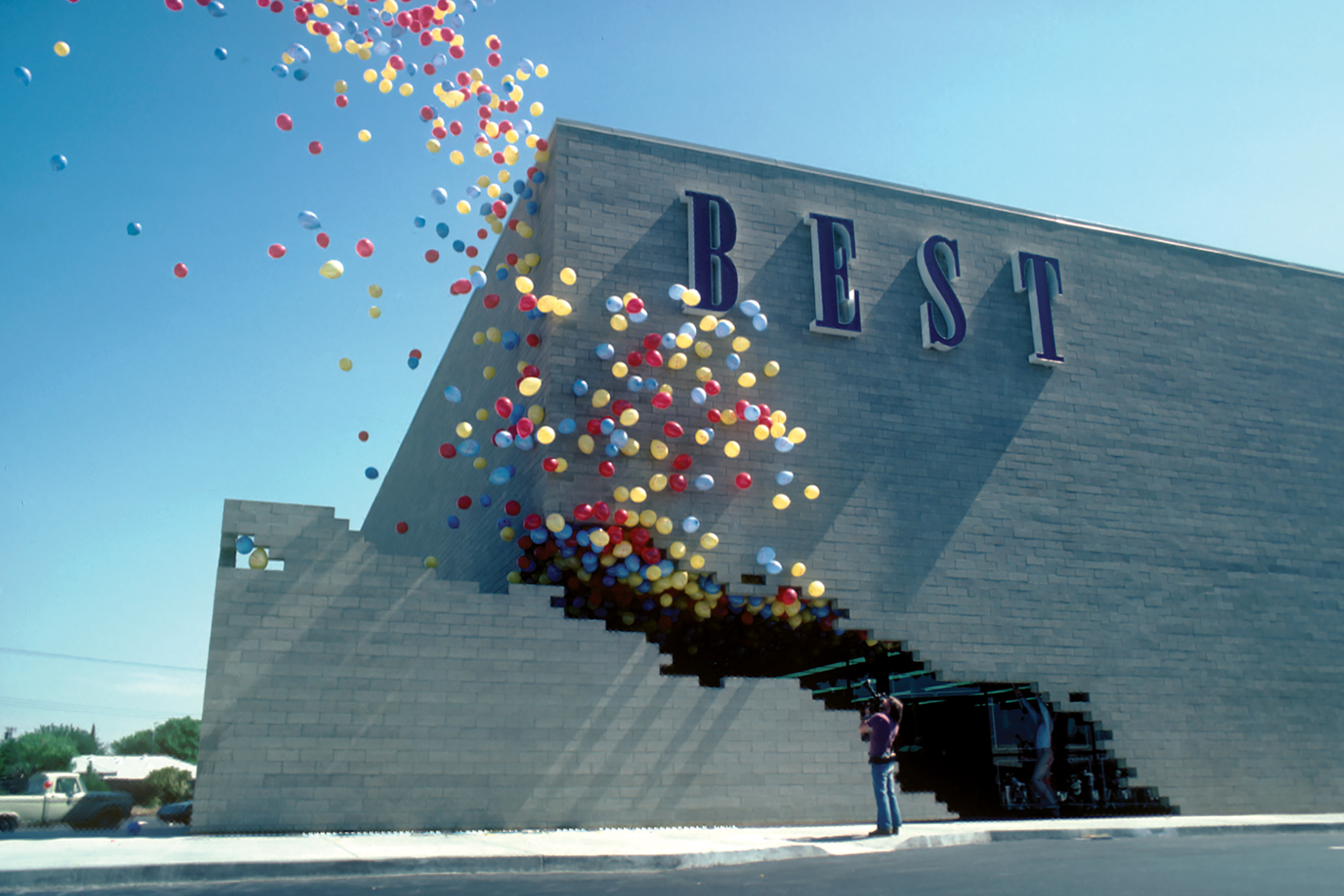 SITE for Best Products Company Inc., BEST Notch Building, Miami, FL, 1979
SITE for Best Products Company Inc., BEST Notch Building, Miami, FL, 1979It is ironic that this window sparked SITE’s collaboration with Smith and Mallet, not only because it was on display for just one day, but also because at that point in the early eighties, SITE had a high-profile international reputation as the subversive pranksters of architecture. Their radical work for BEST chain stores from 1975 to the early eighties achieved something unimaginable. They simultaneously functioned as big box retail stores and giant conceptual sculptures that critiqued the conventions of the big box genre. Eleven different BEST stores were built in total. Each had its own subversive focal point. The 1975 Houston, Texas, store, Indeterminate Facade, featured an apocalyptic roofline of crumbling brick. The 1976 Towson, Maryland, store, Tilt Building, permanently pivoted the entire facade on a 35-degree angle, allowing customers to walk under the resulting chasm and enter through a second hidden glass facade. And the 1980 Richmond, Virginia, store, Forest Building, was designed to allow nature to grow through the facade. “There was lots of controversy swirling around those stores because they used architecture to comment on itself,” explains James Wines, another SITE cofounder.
On paper, the charismatic Wines could have been considered the polar opposite of Smith. Wines is straight, white, and was about fifteen years his client’s senior. Smith was openly gay, Black, and young (early thirties). But beyond these inverse identifying distinctions were two men with profound similarities: both functioned as artists but had chosen to work in commercial fields; both had a taste for fully immersive art, such as theater and land art; both were drawn to works that had a component of social critique; both had a reputation for bucking convention; and both were media darlings.
These affinities sparked an immediate friendship. Wines fondly recalls, “Willi was like an Oscar Wilde character—good looking, charismatic, and not at all pretentious. When you read Wilde you see that he punctures holes in everything and Willi had a bit of that in him too. A conversation with him wasn’t like talking to Donna Karan, it was like talking with an artist. When Alison and I got to know him it was almost like we had known each other our whole lives.”
These affinities sparked an immediate friendship. Wines fondly recalls, “Willi was like an Oscar Wilde character—good looking, charismatic, and not at all pretentious. When you read Wilde you see that he punctures holes in everything and Willi had a bit of that in him too. A conversation with him wasn’t like talking to Donna Karan, it was like talking with an artist. When Alison and I got to know him it was almost like we had known each other our whole lives.”
 James Wines of SITE for WilliWear, Showroom Drawing,
New York, NY, 1980
James Wines of SITE for WilliWear, Showroom Drawing,
New York, NY, 1980“Willi was like an Oscar Wilde character—good looking, charismatic, and not at all pretentious. When you read Wilde you see that he punctures holes in everything and Willi had a bit of that in him too. A conversation with him wasn’t like talking to Donna Karan, it was like talking with an artist.”
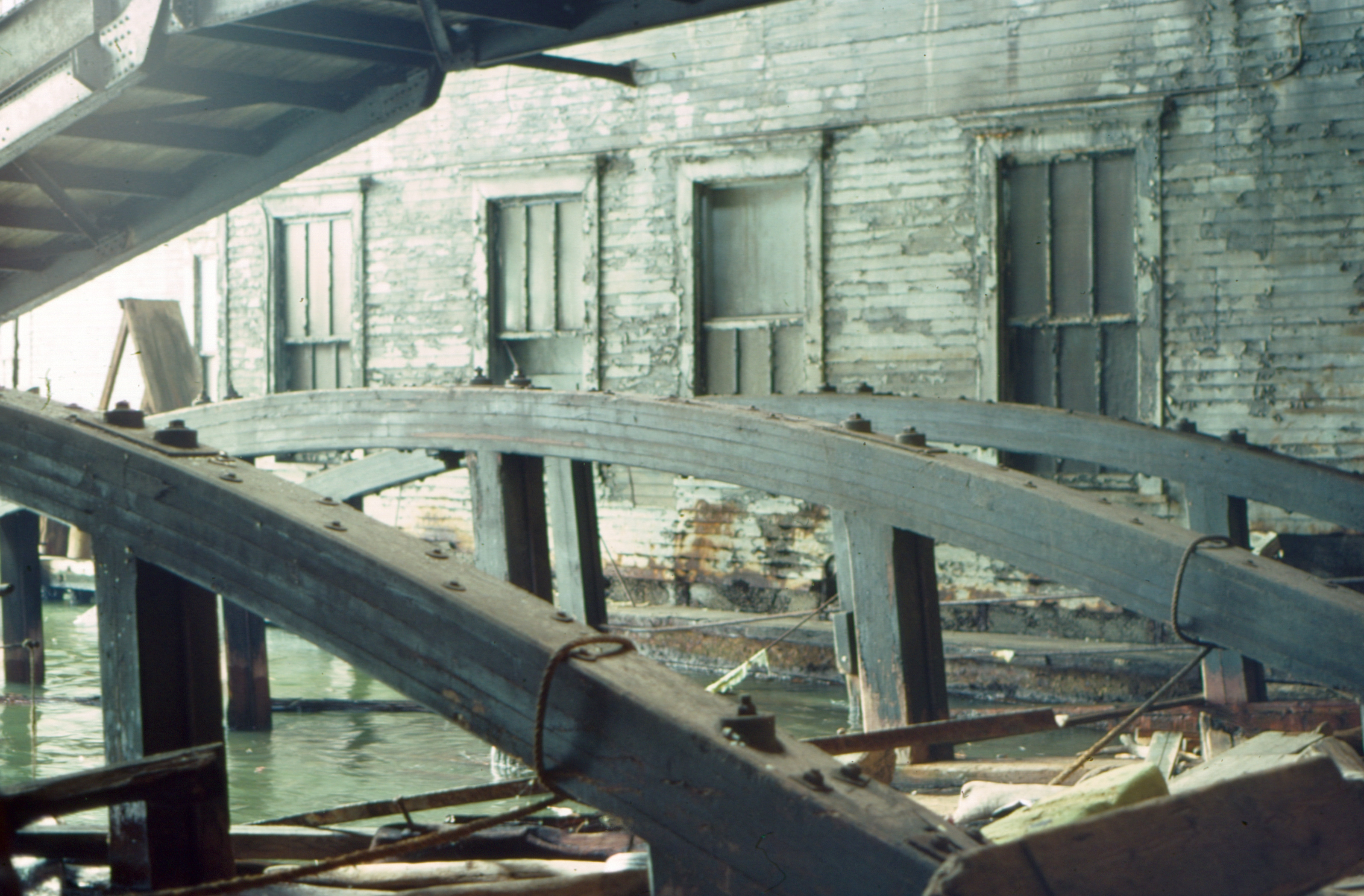
SITE for WilliWear, Showroom Inspiration, 1984
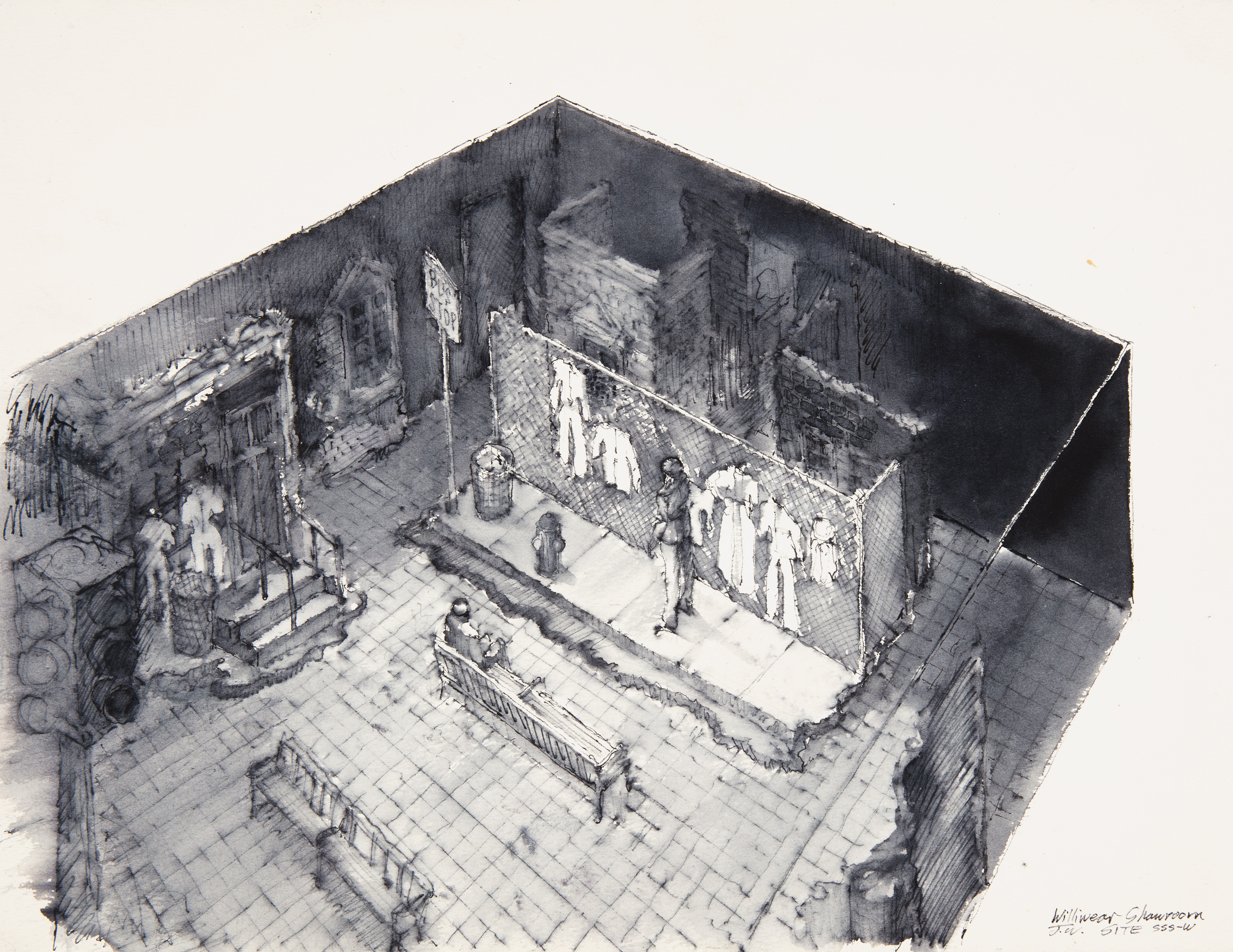
James Wines of SITE for WilliWear, Showroom Drawing, New York, NY, 1983
Sky and Wines interviewed Smith and Mallet in order to understand WilliWear’s goals and dreams. Wines explains, “He told me he wanted his showroom to be the exact opposite of Ralph Lauren. He was not interested in aspirational wealth. He was interested in looking good, being cultured, and enjoying pleasure, and he wanted to share those interests with as many people as possible.” Sky adds, “It can be difficult to answer such simple questions, but when we asked where his inspiration came from he told us it’s from watching people on the street. When he said that, it was so evocative that he didn’t have to say more.” SITE’s conceptual proposal was equally simple. “We said, ‘Let’s just do the street. Let’s bring the street into the showroom.’ And he loved that idea.” For the next step of the process, Smith gave Wines a tour of the Christopher Street Pier, then a notorious gay cruising spot, in order to point out areas that featured his favorite textures, materials, and atmospheres. “He highlighted particular arrangements, specific portions of corrugated metal and pipes. He also took me to the gay bars around the waterfront. He preferred the rough spots: The Hellfire, The Anvil, places that had a very strong character,” recalls Wines. Together SITE and Smith embarked on recreating and repurposing the mood and attitude of places in the city that inspired Smith the most, and formed a team to scour the streets after midnight for authentic discarded materials.
The WilliWear women’s showroom opened in 1982 at 209 West 38th Street in New York City’s Garment District. In many ways it took the original concept from the window display and expanded it into an entire world. The interior featured a detailed streetscape complete with brick and cinderblock facades, multiple doors and windows, sidewalks, window grates, and multiple styles of fencing. In this interior streetscape, elements had multiple functionalities—the city fences and window bars doubled as display racks, which allowed for maximum flexibility for hangers, and the sidewalk doubled as a fashion show runway. Like the bookstore, the reception desk was an unfinished brick wall and the whole interior was painted a specific light pale gray visually unifying the compli- cated space into one cohesive dreamscape. This device animated the vitality in Smith’s work, making the outfits the sole inhabitants of this surrealist ghost city.

SITE for WilliWear, Showroom, New York, NY, Photographed by Andreas Sterzing, 1982



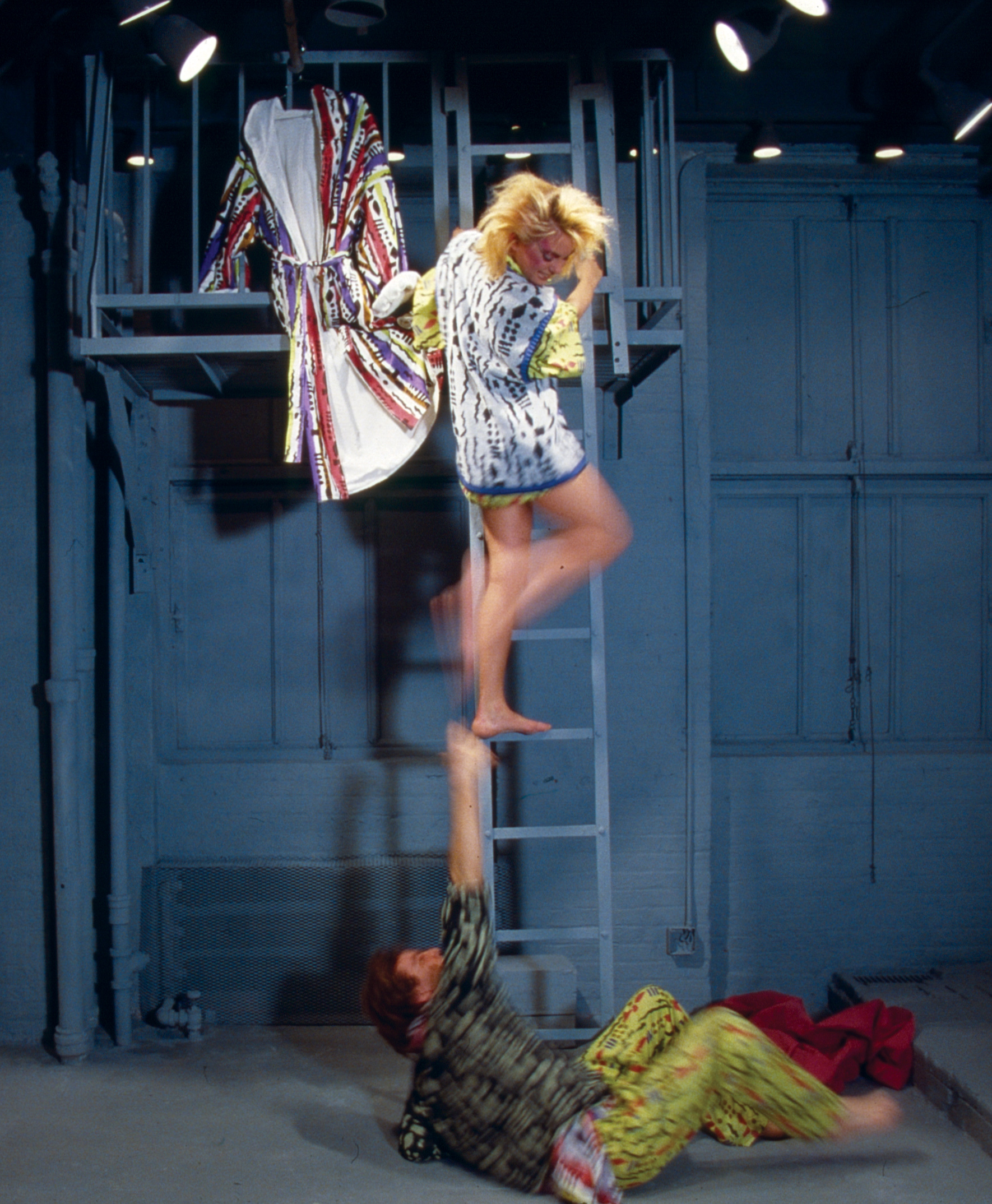
SITE for WilliWear, Showroom, New York, NY, Photographed by Andreas Sterzing, 1984
The men’s showroom opened up later the same year; it utilized the same strategies but visually took its cues directly from the abandoned warehouses on the piers, using as many real materials as possible. “The interiors had architectural plans but their creation was very much about being in the location with the collected materials and collaging the pieces together. The way we work is equally art and design, and art requires you being there and experiencing what works in the moment and making adjustments,” Wines says of their process. Both of these unconventional interiors were extremely successful. As Sky recalls, “They were places people wanted to stay in and functioned
wonderfully for buyers, fashion shows, and celebrations. They were completed by the
vibrant clothing and people who entered.”
In 1997, writer and architectural critic Aaron Betsky’s book Queer Space: Architecture and Same-Sex Desire sought to redefine spaces like the Chelsea Piers during the eighties, describing them as a misuse or deformation of a place, an appropriation of the buildings and code of the city for perverse purposes. Betsky found this type of space liberating and believed it was vital in helping residents alleviate some of the imprisoning characteris- tics of the modern city. But long before queer architecture was validated by academia, Smith harnessed this energy, parading his industry’s crème de la crème—fashion editors, models, and celebrities—through a space modeled after a location notorious for anonymous, public, gay sex; the ultimate subversive political act for a daring, out fashion designer. Whatever his intentions were the designer was quite buttoned up about them. “He may or may not have used the piers for pleasure. That was his private life and it was private. It never seemed to me like Willi had an agenda. I think he was inspired by the piers because they were seductive and real,” Wines explains. Even designer Andre Walker, who worked in the men’s showroom from 1988 to 1989, was not aware of their origins. “The fact that it was a reference to the piers went over my head. I just thought it was a cool street/urban vibe. It’s also quite telling that they didn’t change the showroom decor for over seven years.”
In 1997, writer and architectural critic Aaron Betsky’s book Queer Space: Architecture and Same-Sex Desire sought to redefine spaces like the Chelsea Piers during the eighties, describing them as a misuse or deformation of a place, an appropriation of the buildings and code of the city for perverse purposes. Betsky found this type of space liberating and believed it was vital in helping residents alleviate some of the imprisoning characteris- tics of the modern city. But long before queer architecture was validated by academia, Smith harnessed this energy, parading his industry’s crème de la crème—fashion editors, models, and celebrities—through a space modeled after a location notorious for anonymous, public, gay sex; the ultimate subversive political act for a daring, out fashion designer. Whatever his intentions were the designer was quite buttoned up about them. “He may or may not have used the piers for pleasure. That was his private life and it was private. It never seemed to me like Willi had an agenda. I think he was inspired by the piers because they were seductive and real,” Wines explains. Even designer Andre Walker, who worked in the men’s showroom from 1988 to 1989, was not aware of their origins. “The fact that it was a reference to the piers went over my head. I just thought it was a cool street/urban vibe. It’s also quite telling that they didn’t change the showroom decor for over seven years.”
Building on this momentum, SITE embarked on another round of projects. Next was Smith’s personal office, which was an extension of the pier theme in the men’s showroom. In London they took over a corner of Harrod’s, the prestigious upscale department store, and turned it into a permanent construction site. The Los Angeles showroom was a ghost beach, and the flagship store on Fifth Avenue in Manhattan featured an elaborate urban park in which monochrome light-gray ivy had overtaken the entire retail environment. The final project in 1985 was Mallet’s private residence, which again extended SITE’s strategies, ghosting a Greenwich Village townhouse.

SITE for WilliWear, Showroom, New York, NY, 1984

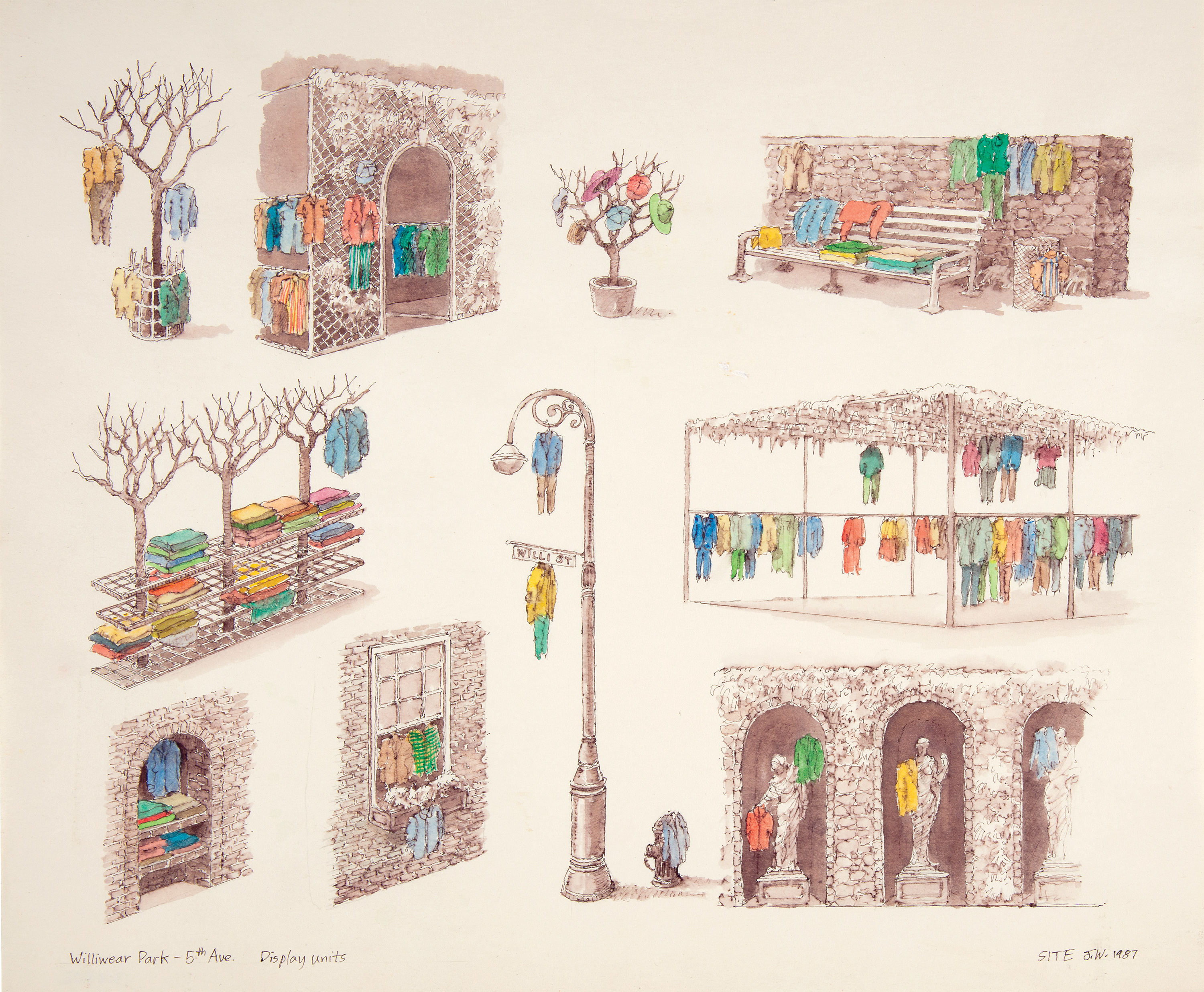
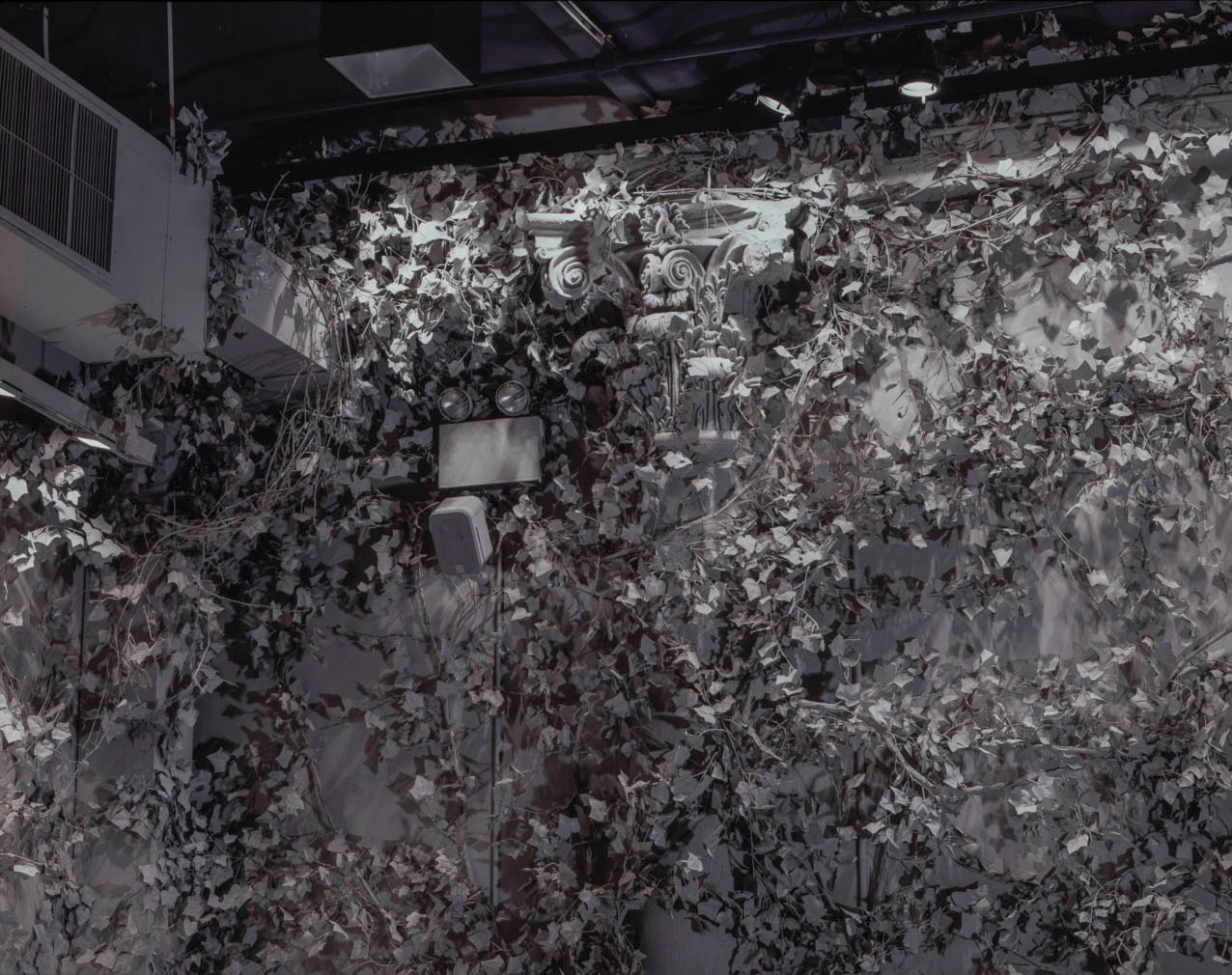

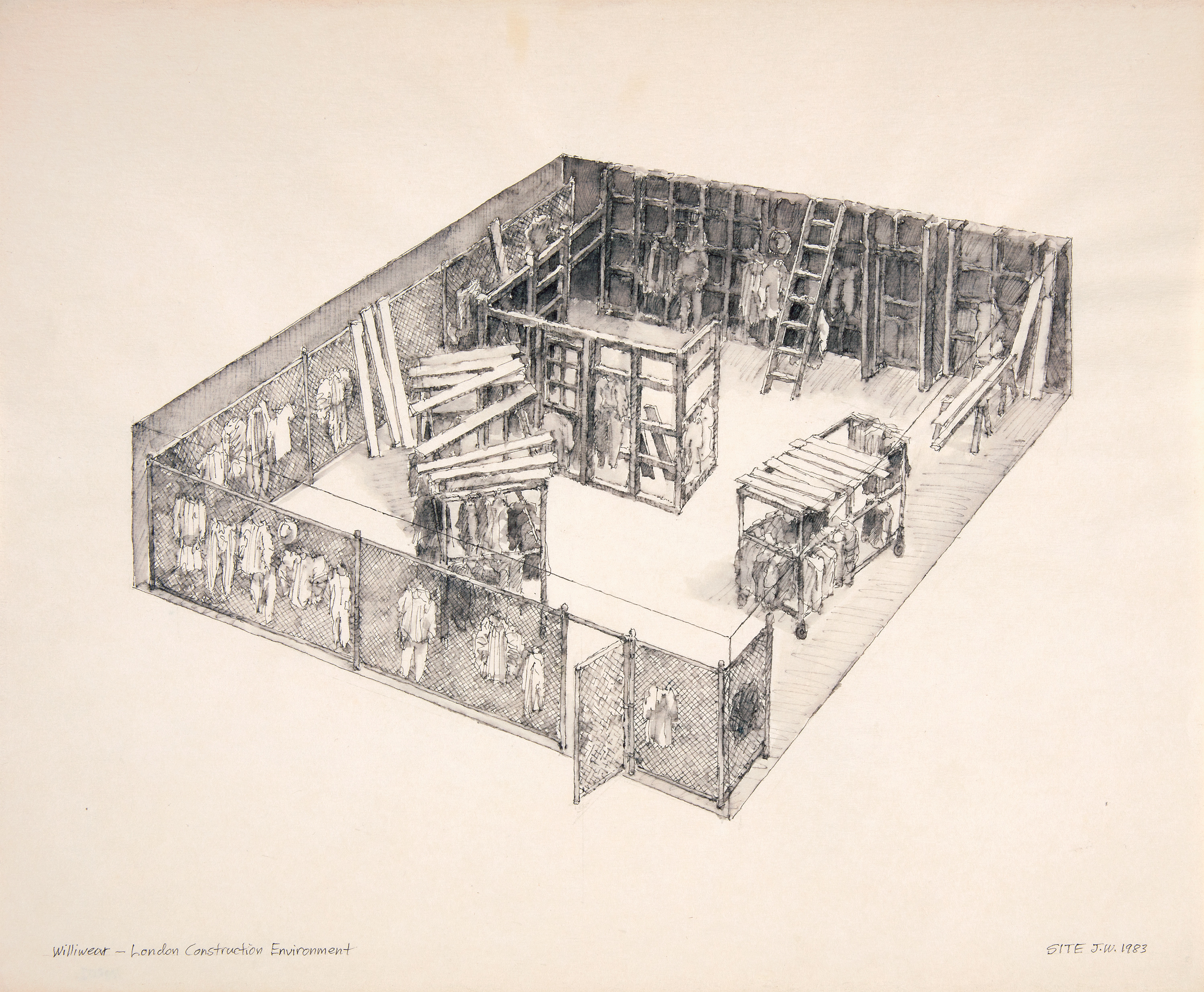
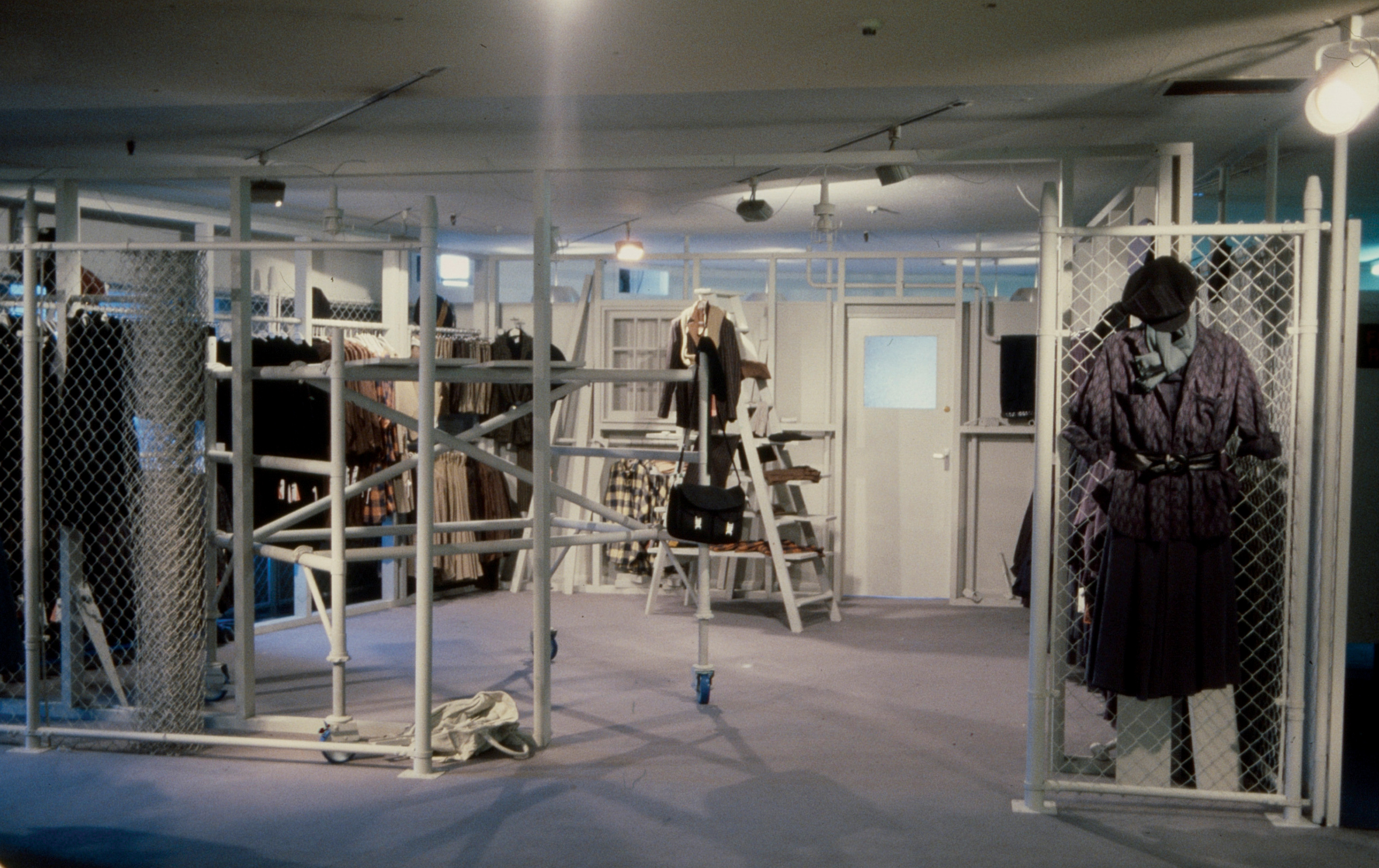
SITE and Smith collaborated successfully because at the
core of their practices was the concept of starting with
common references. Wines elaborates, “In order to make
a strong statement that can affect that most diverse audience, you have to begin with what’s common. We really
shared that, a conception of starting with the commonplace but then making an intervention that changes the meaning. That is a powerful act. Everyone can relate to the ordinary, but then they experience something extraordinary. We both had a mission of putting art in places where you least expected to find it.”
Michael Bullock is a writer who has been actively involved in independent magazine publishing for over a decade. He contributes regularly to the architecture and design publication PIN–UP.
Rebellion in Design: Developing a Blueprint for the Future
Virgil Abloh (Chief Creative Director and founder of Off-White™️ and Men’s Artistic Director at Louis Vuitton) and architect James Wines (Founder, SITE; 2013 National Design Award winner) in conversation with interdisciplinary architect Oana Stănescu on the cross-sections of fashion and architecture as related to the making of spaces and culture, and disrupting hegemony through design.
